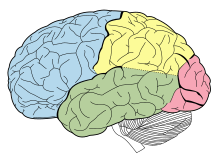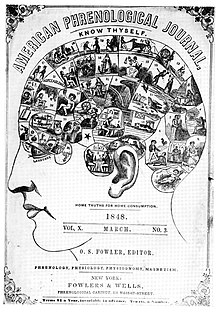User:EmmaMallory/Functional Specialization of the Brain

Functional Specialization suggests that there are different areas in the brain that are specialized for different functions. [1]
Historical Origins[edit]

This modern cognitive neuroscience development derived from the controversial pseudoscience phrenology created by Franz Joseph Gall (1758-1828) and Johann Gaspar Spurzheim (1776-1832). Most well known for the fact that one’s personality could be determined by the variation of bumps on their skull, phrenology actually came up with the first assumption that different regions in one’s brain have different functions and may very well be associated with different behaviours. [2]

A railroad construction worker named Phineas Gage contributed to the history of functional specialization on September 13th 1848 by being one of the first lesion case studies. Gage accidently set off an explosive causing his iron tampering rod to penetrate behind his left eye and pierced through the orbitofrontal area of his frontal cortex.
Gage survived and recovered from his physical injury however his friends described him as, “no longer being Gage.” (Stuss & Knight, 2002) It was clear that Gages personality was altered after his brain damage but the real finding here was that the lesions to the frontal lobes caused changes in personality while keeping other modalities such as sensation, movement, consciousness and many cognitive facilities intact. (Stuss & Knight, 2002) Recent studies on the frontal lobe support Gages evidence towards functional specialization. The orbitofrontal cortex damage was seen to be involved in the modulation of reactive aggression and antisocial behaviour because its decreased ability to inhibit these responses. (Blair, 2004)
Major Theories of Functional Specialization[edit]
Distributive Processing[edit]
One of the theories of cognition in the brain supports that there is a distributive processing and interconnectedness of regions in the brain. Although functional specialization suggest that there are specialized neural systems that process specific modalities, distributive processing argues that the nervous system integrates activity, for example seen across sensory systems.(Stein and Meredith, 1993) Researchers who support this theory and provide evidence towards it include Anthony McIntosh, who has conducted many studies and written about the interconnectedness of the brain, and William Uttal, who debates and questions localization and modality specialization and produces signs against its many influential assumptions.
McIntosh research suggests that human cognition involves interactions between the brain regions that are responsible to processes sensory information such as vision and audition and other mediating areas, such as the prefrontal cortex. McIntosh explains that modularity is mainly observed in sensory and motor systems but that beyond the very receptors for them, modularity becomes ``fuzzier`` and you see the cross connections between systems increase. (McIntosh, 1999) He also illustrates that there is an overlapping of functional characteristics in the sensory and motor systems where these regions are close of one another. These different neural interactions influence each other, for example, the activity changes in one area influences its other connected areas and with this, McIntosh suggest that if you only focus on activity in one area, you may miss the changes in other integrative areas. (McIntosh, 1999) Neural interactions can be measured using analysis of covariance in neuroimaging and in one of these analysis, McIntosh brings a clear example of the interaction theory of cognition. As subjects learned that an auditory stimulus signalled a visual event, activation (an increase blood flow) of an area in the occipital cortex, a region of the brain involved in visual processing (Zeki, 1993), was found when the auditory stimulus was presented alone. Correlations between the occipital cortex and different areas of the brain such as the prefrontal cortex, premotor cortex and superior temporal cortex showed a pattern of co variation and functional connectivity between these areas. (McIntosh et at., 1998)
Uttal writes about the limits of localizing cognitive process in the brain. One of his main arguments is that cognitive neuroscience`s research since the late 90`s have forgotten about conventional psychophysical studies based on behavioural observation and have mainly focussed on the technological advances of brain imaging techniques such as MRI and PET scans. Because of this, he suggest that this science is now depending on the assumptions about localization and hypothetical cognitive modules using these imaging techniques to pursuit these assumptions. The problem here is that there have been many controversies with the validly, over assumptions and strong inferences some of these images are trying to illustrate. An example of one of the main issues has to do with using the right control image in an experiment. Because most of the cerebrum is active during cognitive activity, the amount of increase activity in a region must be greater compared of a controlled area. Here you can see how there may be a production of false or over exaggerated findings as well as a potential tendency to ignore regions of diminished activity which may also be also critically involved in the cognitive process being studied. (Uttal, 2002) and (find other classmates doing this page and link title) Uttal also states that localization researchers seem to ignore how complex the nervous system is. Many of the brain`s parts are physically interconnected in a nonlinear system and Uttal explains that because of this, a behaviour can be produced by a variety of different system organizations.(Uttal, 2002)
Modularity[edit]
Examples of Modularity in the Brain[edit]
Additional Images[edit]
 |
 |
References[edit]
McIntosh, A. R. (1999). Mapping Cognition to the Brain Through Neural Interactions. Univeristy of Toronto, Canada. Psychology Press, 523-548
Stein, B., Meredith, M. (1993) Merging of the Senses. Cambridge, MA: MIT Press.
McIntosh, A.R., Cabeza, R. E., and Lobaugh, N., J. (1998). Analysis of Neural Interactions Explains the Activation of Occipital Cortex by an Auditory Stimulus. The Journal of Neurophysiology Vol. 80 No. 5, pp. 2790-2796
Zeki,S. (1993). A vision of the brain. Cambridge, MA, US: Blackwell Scientific Publications.
Uttal, W.R. (2002). Précis of The New Phrenology: The Limits of Localizing Cognitive Processes in the Brain. Department of Industrial Engineering, Arizona State University, USA.
Duncan, J., & Owen, A. (2000). Common regions of the human frontal lobe recruited by diverse cognitive demands. Elsevier Science.
Flourens, M. J. P. (1824) Recherces experimentales sur les propretes et les fonctions du systeme nerveux dans les animaux vertebres. Paris: J.B. Balliere.
Fuster, J. (2008). The Prefrontal Cortex. Elsevier. (pg 178-353)
Lashley, K.S. (1929) Brain mechanisms and intelligence. Chicago: Chicago University Press.
Stuss, D., and Knight, R. (2002) Principles of Frontal Lobe Function. Oxford University Press US (pg 1-10)
Blair., R. (2004) The roles of orbital frontal cortex in the modulation of antisocial behaviour Brain and Cognition 55 pp. 198–208
